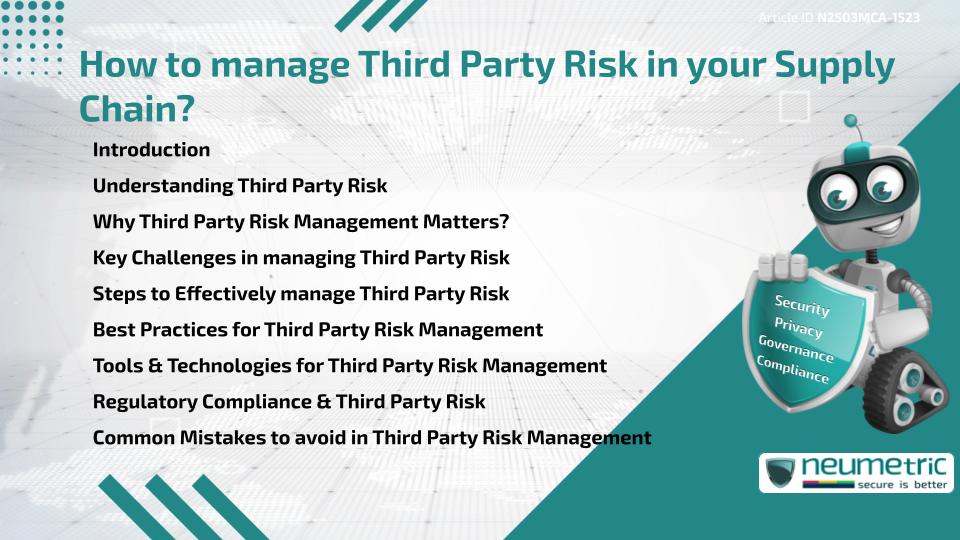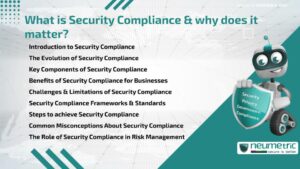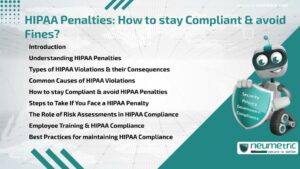Table of Contents
ToggleIntroduction
Businesses rely on Third Parties for various Services, from Cloud Computing to Payment processing. While these Partnerships offer efficiency & expertise, they also introduce Risks. Understanding How to manage Third Party Risk is essential to safeguard Sensitive Data, maintain Compliance & ensure Operational continuity.
Understanding Third Party Risk
Third Party Risk refers to the Potential Threats that arise when Companies outsource Services or rely on External Vendors. These Risks can include Data Breaches, Financial losses, Compliance violations & Reputational damage.
Why Third Party Risk Management Matters?
Effective Third Party Risk Management helps Businesses prevent Security Incidents, reduce Regulatory penalties & maintain trust with Customers & Stakeholders. Neglecting this area can result in Costly disruptions & Legal consequences.
Key Challenges in managing Third Party Risk
- Lack of Visibility: Many Companies struggle to gain complete insight into their Third Parties’ Security practices.
- Compliance Issues: Vendors must adhere to Industry Regulations such as GDPR, HIPAA or ISO 27001.
- Operational Disruptions: A Cendor’s failure can impact Business Continuity.
- Supply Chain Attacks: Cybercriminals often target Vendors to gain access to Sensitive Systems.
Steps to Effectively manage Third Party Risk
- Identify & Assess Vendors: Classify Third Parties based on the level of Risk they pose.
- Conduct Risk Assessments: Evaluate each Vendor’s Security Policies, Compliance Posture & Potential Vulnerabilities.
- Establish Clear Contracts: Define Security requirements, responsibilities & breach notification procedures.
- Monitor Vendor Performance: Regularly review Third Party activities & conduct periodic Audits.
- Develop Incident Response Plans: Prepare for potential Third Party-related Security Breaches.
Best Practices for Third Party Risk Management
- Implement a Risk-Based Approach: Prioritise Vendors based on their Risk level.
- Use standardised Assessments: Utilize Frameworks like NIST, ISO 27001 or SOC 2.
- Foster Strong Vendor Relationships: Maintain open Communication with Third Parties.
- Leverage Automation: Use Third Party Risk Management Platforms for Continuous Monitoring.
- Train Internal Teams: Educate Employees on identifying & mitigating Third Party Risks.
Tools & Technologies for Third Party Risk Management
Various Technologies help Businesses track & manage Third Party Risks, including:
- Vendor Risk Management [VRM] Software
- Security Ratings Platforms
- Continuous Monitoring Solutions
- Compliance Management Tools
Regulatory Compliance & Third Party Risk
Many industries require Organisations to manage Third Party Risks to meet Compliance Standards. Regulations like GDPR, HIPAA & SOC 2 mandate stringent vendor Risk Management Processes.
Common Mistakes to avoid in Third Party Risk Management
- Ignoring Small Vendors: Even smaller Vendors can pose significant Risks.
- One-Time Assessments: Regular Monitoring is essential.
- Lack of Defined Responsibilities: Clear Contracts prevent misunderstandings.
- Failure to Act on Red Flags: Addressing Vendor Security issues promptly reduces exposure.
Takeaways
Managing Third Party Risk requires a proactive & structured approach. By identifying Risks, implementing strong Security Measures & maintaining continuous oversight, Businesses can minimise Threats & ensure smooth Operations.
FAQ
What is Third Party Risk?
Third Party Risk refers to Potential Threats that arise from outsourcing Services to External Vendors, including Security, Compliance & Operational Risks.
How can Businesses assess Third Party Risks?
Businesses can conduct Vendor Assessments, review Security Policies, check Compliance Certifications & Monitor Third Party activities.
Why is Continuous Monitoring important in Third Party Risk Management?
Continuous Monitoring ensures Vendors maintain Security & Compliance Standards over time, reducing exposure to emerging Risks.
What Industries need Third Party Risk Management?
Industries like Finance, Healthcare, Technology & Government require Third Party Risk Management due to strict Regulatory requirements.
How do Automated Tools help in Third Party Risk Management?
Automated Tools streamline Vendor Assessments, Monitor Compliance & provide Real-time alerts on Security Vulnerabilities.
What are common Compliance Frameworks for Third Party Risk Management?
Common Frameworks include NIST, ISO 27001, SOC 2 & GDPR Guidelines.
What should be included in Vendor Contracts for Risk Management?
Contracts should define Security requirements, Compliance obligations, Breach Notification Protocols & Termination Clauses.
How often should Businesses assess their Third Party Vendors?
Regular Assessments, such as Annual or Biannual Reviews, help maintain ongoing Vendor Security & Compliance.
What are the Consequences of failing to manage Third Party Risk?
Failure to manage Third Party Risk can lead to Data Breaches, Regulatory fines, Operational disruptions & Reputational damage.
Need help?
Neumetric provides organisations the necessary help to achieve their CyberSecurity, Compliance, Governance, Privacy, Certifications & Pentesting goals.
Organisations & Businesses, specifically those which provide SaaS & AI Solutions, usually need a CyberSecurity Partner for meeting & maintaining the ongoing Security & Privacy needs & requirements of their Clients & Customers.
SOC 2, ISO 27001, ISO 42001, NIST, HIPAA, HECVAT, EU GDPR are some of the Frameworks that are served by Fusion – a centralised, automated, AI-enabled SaaS Solution created & managed by Neumetric.
Reach out to us!





